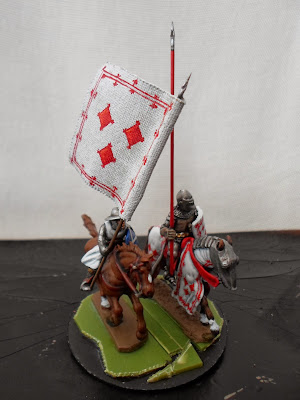It has been a good twelve months spent almost exclusively painting stuff for my 1314 project, but I am, indeed, almost there.
By the middle of last week, and with time off this week to look after my children (some poor soul has to and they are at least mine!), I expect to have completed my painting of all the units for "Phase 1" by the start of November, leaving varnishing and basing to complete by December 1st and the "Wargamer" show..
Yet, in a last minute attempt to make my job harder, I made a decision regarding those final troops, which were to consist of Angus Og MacDonald (a three figure command element) and 16 Islesmen with two-handed axes. I could have bought some Redoubt Gallowglasses and, had they had them at Derby (apparently, they do not take their Renaissance ranges to shows), would have. I looked at Norse-Gael types in the SAGA starter set too, but there was not enough of what I wanted. I also checked out what appear to be excellent looking figures from Claymore Castings, but baulked a little at the price and I do like to see what I am buying in the flesh.
Thus, I set myself up with a few Fireforge plastics, a box of Viking Hirdmen from Gripping Beast, some brass spears, a few spare 1st Corps command figures and an inch or two of Green Stuff and set about converting a few Islesmen of my own.
Sculpting in this way is something I have not done masses of before, but with which I have dabbled from time to time. My first major foray was the "Medusa Legion", a Warhammer 40K Chaos Space Marine legion I built using plastic fantasy Chaos Warriors, using Green Stuff for horsehair helmet crests because I wanted them to have an Ancient Greek feel to match their "fluff". I continued in this vein with my Death Guard, especially the three Dreadnoughts I built for them from the loyal Space Marine kit. I may post some pics of these old warriors at some point.
So, with various pictures in my head, I set to lengthening mail shirts into hauberks, aketons into more full skirted versions, adding sleeves and hoods and filling a few gaps in the castings after my attempts at changing various arm positions, etc.
They are now undercoated and ready for a paint job. Some of my attempts, as you will see below, are a tad crude, but the whole thing took me just a couple of days' work and was most therapeutic. I will see how they paint up and can always spend some money on replacements if they really do not look the part!!! It is fair to say that I need a lot more practice with the modelling putty and associated tools....
G
 |
| "Swing low..." Fireforge Foot Sergeant in aketon with mail coif head from Mounted Sergeants box. The axe is made by cutting the head from a plastic axe (Fireforge or Gripping Beast to taste). This is obviously the pre-Green Stuff kit. |
 |
| Fireforge body and arms again, but with GB Hirdman head and Danish Axe. I can live with the extra haft thickness on the plastic casting vs my wire and axe head versions. |
 |
| GB Hirdman body and arms, Fireforge head with arming cap and another of "my" axes. |
 |
| Angus Og MacDonald himself. Hirdman body, mailed Fireforge arms, Fireforge helmet with head removed and hollowed out plus another of my axes. The head is also from the GB Hirdmen set. |
 |
| "Swing low..." with his mail coif extended into a mail cape. |
 |
| And from behind. The sword is from my bits box. |
 |
| Arming cap man, now also with a mail cape. |
 |
| Yet another mail cape on the figure from the second photo above. I tried to blend the Green Stuff into the mail "skirt" around the back of the helmet in order to make it a continuous thing. |
 |
| I did rather more work on Angus, extending his shirt into a hauberk and adding short outer sleeves to hide the mismatch between the GB body and Fireforge arms. I also added a mail hood attached to his hauberk. It must be a warm day in the Hebrides since he has doffed his headgear. |
 |
| Angus again. A bit more work on his right sleeve would have been beneficial. |
 |
| I am happier with his left sleeve. |
 |
| Another extended shirt into hauberk conversion, this figure will carry Angus' banner. I tried to create a sense of movement in the skirt. |
 |
| And another hood attached to a mail shirt. |



























































